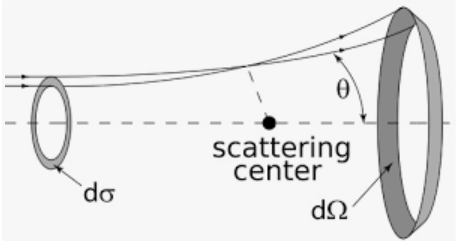
Assume you have chosen coordinates for a system that are not independent, but
are connected by m equations of constraints of the form
Σkalk
dqk
+ alt dt = 0, l = 1, ..., m.
Then the equations of motion can be obtained from
d/dt(∂L/∂(dqk/dt)) - ∂L/∂qk = ∑lλlalk, (n equations), Σkalk dqk + alt dt = 0 (m equations).
We have m + n equations and m + n unknowns, the n coordinates and the m λ's. The λl are called the undetermined Lagrange multipliers, ∑lλlalk is the generalized force of constraint associated with the coordinate qk.
Link: Hamilton's principle and Lagrange multipliers
Consider the scattering of a particle by a
central
potential.
We define the differential scattering cross section
σ(Ω) = dσ/dΩ through the expression
# of particles scattered into the solid angle dΩ per unit time = I σ(Ω) dΩ,
where I
is the intensity of the incident beam, i.e. the number of beam
particles per unit area per unit time.
For a central potential σ(Ω) is independent of
φ.
We write
σ(Ω) = σ(θ)
= dσ/dΩ.
The number of particles scattered through an angle between
θ and
θ
+ dθ
per unit time is
I σ(θ) 2π sinθ
dθ.

We define the impact parameter b
through
M = mv0b = b(2mE)½,
where M is the angular momentum and v0 is the incident speed at
infinite distance.
Once E and b are fixed, the scattering angle is uniquely
determined.
A particle incident with impact parameter between b and b + db will be scattered
through an angle between
θ and
θ + dθ. We can write
I 2π σ(θ) sinθ dθ
= -I 2π b db,
σ(θ)
=|(b/sinθ)(db/dθ)|.
In a central potential the motion is in a plane and M and E are constant.
E = ½m(dr/dt)2 + M2/(2mr2) + U(r) = ½m(dr/dt)2 + b2E/r2 + U(r), since M = mv0b =
b(2mE)½.
dr/dt = ±[(2/m)(E(1 - b2/r2) - U(r))]½.
M = mr2(dφ/dt), d/dt = [M/(mr2)]d/dφ = [b(2mE)½/(mr2)]d/dφ.
From dr/dt = [(2/m)(E(1 - b2/r2) - U(r))]½
we then find the equation for the trajectory.
dr/dφ = [(2/m)(E(1 - b2/r2) - U(r))]½/ [b(2mE)½/(mr2)]
= [(E½ (1 - b2/r2) - U(r))]½/ (b/r2).
dφ/dr = (b/r2)/ [(E½ (1 - b2/r2) - U(r))]½.
dφ/du = -b/ [(E½ (1 - b2u2) - U(u))]½, with u = 1/r.
φ(u) = b∫0udu'/[1 - b2u'2 - U(u')/E]½, with φ(z = -∞) = 0.
Let θ be
the angle between the incident and the scattered direction and φ0 be the angle between
r(z =
-∞)
and rmin.
Then
φ0 = b∫0umaxdu'/[1
- b2u'2 - U(u')/E]½,
and
E =
M2/(2mr2min)
+ U(rmin) = b2E/r2min
+ U(rmin) = b2Eu2max
+ U(umax)
determines umax. We have
θ
= π - 2φ0
for a repulsive potential,
|θ|
= 2φ0 - π
for an attractive potential, or θ = π - 2φ0, θ
< 0.

If U(r) = α/r, U(u) = αu, U(umax) = αumax, then
umax = -α/(2b2E) + [α2/(4b4E2)
+ 1/b2]½ and φ0
= cot-1(α/(2bE)).
cotφ0
= α/(2bE), cot(θ/2) = cot(π/2 - φ0) = tanφ0
= 1/cotφ0.
b = [α/(2E)] cot(θ/2), db/dθ = -½[α/(2E)]sin-2(θ/2),
σ(θ) = ¼[α/(2E)]2sin-4(θ/2).
This is the Rutherford's formula.
Let θ be the scattering angle in the lab frame and θ0 be the
scattering angle in the CM frame. The number of particles scattered into a detector is the same in the
laboratory and in the CM frame. Therefore
σ(θ) sinθ dθ
=
σ(θ0)
sinθ0 dθ0.